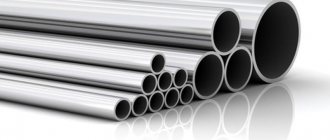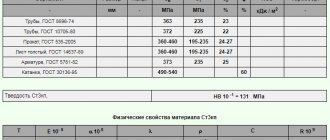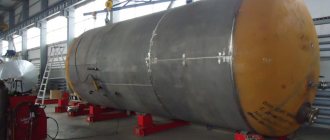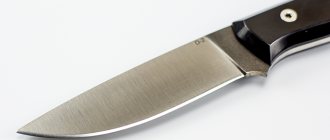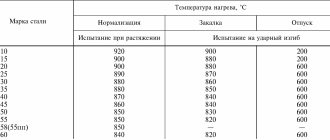How does the abbreviation stand for?
Decoding of ST3PS steel is carried out in accordance with Gosstandart 380-2005:
- St – steel with a predominance of carbon;
- 3 – composition number;
- ps – semi-quiet (level of deoxidation).
Designations and interpretation of letters of alloying elements of steels
A – nitrogen (indicated in the middle of the mark) B – niobium C – tungsten D – manganese D – copper E – selenium K – cobalt M – molybdenum N – nickel P – phosphorus P – boron C – silicon T – titanium F – vanadium X – chromium C – zirconium Yu – aluminum Ch – rare earth
Alloy structural steels
At the beginning of the stamp there is a two-digit number indicating the carbon content in hundredths of a percent. Alloying elements are listed below. The number following the symbol of the element shows its content as a percentage; if there is no number, then the content of the element does not exceed 1.5%. Steel 30Х2М. This grade of steel contains about 0.30% carbon, 2% chromium, and less than 1% molybdenum.
Alloy tool steels
At the beginning of the brand there is a single-digit number indicating the carbon content in tenths of a percent. If the carbon content is more than 1%, the number is not indicated; then alloying elements are listed, indicating their content.
Interpretation of steel grade St4sp
Decoding of steel: The letter at the beginning indicates a group of steel which defines the criteria for the ultimate strength for the chemical composition; if there is no letter, then such steel belongs to group A, and is supplied to consumers based on mechanical properties (such steel may have a high sulfur or phosphorus content). Letters St. indicate that the steel is of ordinary quality, although most steels are high quality. The numbers from 0 to 6 are the conventional brand number depending on the chemical composition and mechanical properties. Typically, the higher the number, the more carbon and the greater the strength. In our case, 4 indicates the carbon content in the alloy is 0.18–0.27%. The letters after the brand number indicate the degree of deoxidation: cn - calm. In terms of price, calm steels have become more expensive than semi-calm and boiling steels. Mild steel is steel obtained as a result of deoxidation. It is obtained by deoxidation with aluminum, manganese and silicon. The level of oxygen in it is so reduced that during metal processing no reaction occurs between carbon and oxygen, and the presence of non-metallic slags and their inclusion is reduced to a minimum. Calm steel has a dense structure and good mechanical properties. It is less prone to negative reactions to welding heat and to aging. The features of a homogeneous microstructure give the alloy maximum corrosion resistance and ductility.
Chemical composition
Decoding the steel grade St3 indicates the main components in its composition - iron (97%) and carbon (0.14-0.22%). The main quality of the alloy—its hardness—depends on the carbon concentration. The steel also contains small amounts of:
- manganese – 0.4-0.65%;
- silicon – 0.15-0.17%;
- nickel and chromium – 0.3% each;
- arsenic – 0.08%;
- copper – up to 0.3%;
- sulfur – 0.05%;
- phosphorus – 0.04%;
- nitrogen – up to 0.008%.
A feature of the St3 alloy is the strict regulation of the content of harmful impurities - sulfur and phosphorus. Phosphorus reduces the plasticity of the metal when exposed to high temperatures, and sulfur, when interacting with iron, forms sulfides, causing the phenomenon of red brittleness. It should be noted that there is an increased concentration of nitrogen, which accounts for almost 0.1%. In accordance with GOST 380-2005, the alloy is marked with accompanying indices that indicate the degree of deoxidation, for example, St3Gsp:
- the first two letters indicate carbon steel of ordinary quality;
- the number “3” means the serial number of the brand according to this GOST;
- the sign “G” indicates a modification with a high manganese content;
- “sp”, “kp”, “ps” – degrees of deoxidation.
Substitutes for steel grade St3 can be:
- C245, according to GOST 27772-88;
- C285;
- VSt3Sp.
Foreign analogues are labeled according to different rules:
- A57036, K01804 – USA;
- 40B, 722M24, HFS4 – UK;
- 1.0038, DC03 – Germany;
- E24-2, E24-4 – France;
- SS330, SS400 – Japan;
- Fe360B, Fe360C – Italy;
- G235C – China;
- RSt360B – Austria;
- Fe235D – Hungary.
The product range includes:
- long and shaped steel according to GOST 2591-2006;
- sheets of various thicknesses and stampings;
- pipes and fittings, according to GOST 10705-80;
- tapes and strips that are produced in accordance with GOST 14918-80;
- wire of different sections.
Other alloys from the category Structural carbon steel of ordinary quality
| Alloy grade | GOST | Chem. compound |
| VSt2kp | GOST 380 - 71, the latest version does not contain material | Fefrom 98.3%Mn0.25-0.5%C0.09-0.1%… |
| VSt2ps | GOST 380 - 71, the latest version does not contain material | Fefrom 98.2%Mn0.25-0.5%C0.09-0.1%Si0.05-0.1%… |
| VSt2sp | GOST 380 - 71, the latest version does not contain material | Fefrom 98%Mn0.25-0.5%Si0.12-0.3%C0.09-0.1%… |
| VSt3Gps | GOST 380 - 71, the latest version does not contain material | Fefrom 97.5%Mn0.8-1.1%C0.14-0.2%… |
| VSt3kp | GOST 380 - 71, the latest version does not contain material | Fefrom 98.1%Mn0.3-0.6%C0.14-0.2%… |
| VSt3ps | GOST 380 - 71, the latest version does not contain material | Fefrom 98%Mn0.4-0.65%C0.14-0.2%Si0.05-0.1%… |
| VSt3sp | GOST 380 - 71, the latest version does not contain material | Fefrom 97.8%Mn0.4-0.65%C0.14-0.2%Si0.12-0.3%… |
| VSt4kp | GOST 380 - 71, the latest version does not contain material | Fefrom 98%Mn0.4-0.7%C0.18-0.2%… |
| VSt4ps | GOST 380 - 71, the latest version does not contain material | Fefrom 97.9%Mn0.4-0.7%C0.18-0.2%Si0.05-0.1%… |
| VSt5ps | GOST 380 - 71, the latest version does not contain material | Fefrom 97.7%Mn0.5-0.8%C0.28-0.3%Si0.05-0.1%… |
| VSt5sp | GOST 380 - 71, the latest version does not contain material | Fefrom 97.5%Mn0.5-0.8%C0.28-0.3%Si0.15-0.3%… |
| VSt6ps | GOST 380 - 71, the latest version does not contain material | Fefrom 97.6%Mn0.5-0.8%C0.38-0.4%Si0.05-0.1%… |
| VSt6sp | GOST 380 - 71, the latest version does not contain material | Fefrom 97.4%Mn0.5-0.8%C0.38-0.4%Si0.15-0.3%… |
| St0 | GOST 380 - 2005 | Fefrom 99.6%… |
| St1kp | GOST 380 - 2005 | Fefrom 98.3%Mn0.25-0.5%C0.06-0.1%… |
| St1ps | GOST 380 - 2005 | Fefrom 98.2%Mn0.25-0.5%C0.06-0.1%Si0.05-0.1%… |
| St1sp | GOST 380 - 2005 | Fefrom 98%Mn0.25-0.5%Si0.15-0.3%C0.06-0.1%… |
| St2kp | GOST 380 - 2005 | Fefrom 98.3%Mn0.25-0.5%C0.09-0.1%… |
| St2ps | GOST 380 - 2005 | Fefrom 98.2%Mn0.25-0.5%C0.09-0.1%Si0.05-0.1%… |
| St2sp | GOST 380 - 2005 | Fefrom 98%Mn0.25-0.5%C0.09-0.1%Si0.015-0.3%… |
| St3Gps | GOST 380 - 2005 | Fefrom 97.5%Mn0.8-1.1%C0.14-0.2%… |
| St3Gsp | GOST 380 - 2005 | Fefrom 97.3%Mn0.8-1.1%Si0.15-0.3%C0.14-0.2%… |
| St3kp | GOST 380 - 2005 | Fefrom 98.1%Mn0.3-0.6%C0.14-0.2%… |
| St3ps | GOST 380 - 2005 | Fefrom 98%Mn0.4-0.65%C0.14-0.2%Si0.05-0.1%… |
| St3sp | GOST 380 - 2005 | Fefrom 97.8%Mn0.4-0.65%Si0.15-0.3%C0.14-0.2%… |
| St4kp | GOST 380 - 2005 | Fefrom 98%Mn0.4-0.7%C0.18-0.2%… |
| St4ps | GOST 380 - 2005 | Fefrom 97.9%Mn0.4-0.7%C0.18-0.2%Si0.05-0.1%… |
| St4sp | GOST 380 - 2005 | Fefrom 97.7%Mn0.4-0.7%C0.18-0.2%Si0.15-0.3%… |
| St5Gps | GOST 380 - 2005 | Fefrom 97.3%Mn0.8-1.2%C0.22-0.3%… |
| St5ps | GOST 380 - 2005 | Fefrom 97.7%Mn0.5-0.8%C0.28-0.3%Si0.05-0.1%… |
| St5sp | GOST 380 - 2005 | Fefrom 97.5%Mn0.5-0.8%C0.28-0.3%Si0.15-0.3%… |
| St6ps | GOST 380 - 2005 | Fefrom 97.6%Mn0.5-0.8%C0.38-0.4%Si0.05-0.1%… |
| St6sp | GOST 380 - 2005 | Fefrom 97.4%Mn0.5-0.8%C0.38-0.4%Si0.15-0.3%… |
Purpose of steel grade 3
It is thanks to the advantages of the material that metal processors and builders are eager to buy st3 for their work. Simplicity of welding, strength and ease of use make St3 steel an indispensable assistant in the production of many parts and hardware. It is made from:
- Welded and non-welded structures, the production of parts used at positive temperatures (shields, frames, casings, frames) is carried out.
- Rolled products up to 10 mm thick are used to produce frictionless, low-load parts, such as troughs or machine covers.
- Modified steel is used for the manufacture of channels, angles or I-beams, and shaped outer profiles.
The st3 circle can be used to create mounting fittings, meshes, clamps, water and gas pipes, wire and other elements.
Grade 3 steel is non-floczen sensitive, has no tendency to temper brittleness and has unlimited weldability. The affordable price of St3 also plays a role.
Characteristics of the material. Steel St2kp.
| Brand | Steel St2kp |
| Classification | Structural carbon steel of ordinary quality |
| Application | non-critical parts requiring increased plasticity or deep drawing; lightly loaded elements of welded structures operating under constant loads and at positive temperatures |
Chemical composition in % of the material St2kp
| C | Si | Mn | Ni | S | P | Cr | N | Cu | As |
| 0.09 — 0.15 | up to 0.05 | 0.25 — 0.5 | up to 0.3 | up to 0.05 | up to 0.04 | up to 0.3 | up to 0.008 | up to 0.3 | up to 0.08 |
Mechanical properties at T=20oC of the material St2kp.
| Assortment | Size | Eg. | sв | sT | d5 | y | KCU | Thermal change |
| — | mm | — | MPa | MPa | % | % | kJ/m2 | — |
| The steel is hot rolled. | 20 — 40 | 330-420 | 32 |
| Material hardness St2kp, | HB 10 -1 = 116 MPa |
Technological properties of the material St2kp.
| Weldability: | no limits. |
| Flock Sensitivity: | not sensitive. |
| Tendency to temper brittleness: | not inclined. |
Designations:
| Mechanical properties : | |
| sв | — Short-term strength limit, |
| sT | — Limit of proportionality (yield strength for permanent deformation), |
| d5 | — Elongation at break, |
| y | — Relative narrowing, |
| KCU | — Impact strength, [kJ/m2] |
| HB | — Brinell hardness, |
| Weldability: | |
| no limits | — welding is performed without heating and without subsequent heat treatment |
| limited weldability | — welding is possible when heated to 100-120 degrees. and subsequent heat treatment |
| difficult to weld | — to obtain high-quality welded joints, additional operations are required: heating to 200-300 degrees. during welding, heat treatment after welding - annealing |
Buy steel St2kp (steel 2 boiling)
Pipe Angle Channel Strip Circle Hexagon Reinforcement Square Beam Sheet
Characteristics of steel ST3
All characteristics of steel st3 are regulated by GOST 380-71 standards. Its composition can include from 0.14 to 0.22% carbon. Steel 3 has quality properties, which are determined by weldability, mechanical properties and corrosion resistance. The mechanical characteristics determine which group the steel belongs to: high-strength, regular or high-strength.
Chemical composition of steel ST3
| steel grade | Mass fraction of elements, % | Carbon Manganese | Silicon |
| ST3kp | 0,14-0,22 | 0,30-0,60 | No more than 0.5 |
| ST3ps | 0,14-0,22 | 0,40-0,65 | 0,5-0,15 |
| ST3sp | 0,14-0,22 | 0,40-0,65 | 0,15-0,30 |
| ST3Gps | 0,14-0,22 | 0,80-1,10 | no more than 0.15 |
| ST3Gsp | 0,14-0,20 | 0,80-1,10 | 0,15-0,30 |
Impact strength of rolled steel ST3
| Steel grade* | Rolled thickness | Impact strength, J/cm2, not less | ||||
| KCU | KCV | |||||
| +20°С | -20°С | after mechanical aging | +20°С | 20°C | ||
| ST3ps ST3sp ST3Gps ST3Gsp | 3,0-5,0 | — | 49 | 49 | — | 9,8 |
| 5,1-10,0 | 108 | 49 | 49 | 34 | — | |
| 10,1-26,0 | 98 | 29 | 29 | 34 | — | |
| 26,1-40,0 | 88 | — | — | — | — | |
| * For ST3kp steel, impact strength is not standardized | ||||||
Mass fraction of steel elements St3sp according to GOST 380-2005
| C (Carbon) | Si (Silicon) | Mn (Manganese) | P (Phosphorus) | S (Sulphur) | Cr (Chrome) | Ni (Nickel) | Cu (Copper) | As (Arsenic) | Fe (Iron) |
| 0,14 — 0,22 | 0,15 — 0,3 | 0,4 — 0,65 | < 0,05 | < 0,05 | < 0,3 | < 0,3 | < 0,3 | < 0,08 | rest |
In open-hearth and converter smelting, the share of nitrogen is 0.01%. An increase in N < 0.013% is allowed, provided that the mass fraction of P is reduced by no less than 0.005% for each increase in the mass fraction of nitrogen by 0.001%. TU 14-1-5283-94: at the request of the consumer P < 0.035, S < 0.04.
Characteristics of the material. Steel St2sp.
| Brand | Steel St2sp |
| Classification | Structural carbon steel of ordinary quality |
| Application | non-critical parts requiring increased plasticity or deep drawing; lightly loaded elements of welded structures operating under constant loads and at positive temperatures |
Chemical composition in % of the material St2sp
| C | Si | Mn | Ni | S | P | Cr | N | Cu | As |
| 0.09 — 0.15 | 0.15 — 0.3 | 0.25 — 0.5 | up to 0.3 | up to 0.05 | up to 0.04 | up to 0.3 | up to 0.008 | up to 0.3 | up to 0.08 |
Mechanical properties at T=20oC of the material St2sp.
| Assortment | Size | Eg. | sв | sT | d5 | y | KCU | Thermal change |
| — | mm | — | MPa | MPa | % | % | kJ/m2 | — |
| The steel is hot rolled. | up to 16 | 340-440 |
| Material hardness St2sp, | HB 10 -1 = 116 MPa |
Technological properties of the material St2sp.
| Weldability: | no limits. |
| Flock Sensitivity: | not sensitive. |
| Tendency to temper brittleness: | not inclined. |
Designations:
| Mechanical properties : | |
| sв | — Short-term strength limit, |
| sT | — Limit of proportionality (yield strength for permanent deformation), |
| d5 | — Elongation at break, |
| y | — Relative narrowing, |
| KCU | — Impact strength, [kJ/m2] |
| HB | — Brinell hardness, |
| Weldability: | |
| no limits | — welding is performed without heating and without subsequent heat treatment |
| limited weldability | — welding is possible when heated to 100-120 degrees. and subsequent heat treatment |
| difficult to weld | — to obtain high-quality welded joints, additional operations are required: heating to 200-300 degrees. during welding, heat treatment after welding - annealing |
Buy steel St2sp (steel 2 calm)
Pipe Angle Channel Strip Circle Hexagon Reinforcement Square Beam Sheet
Advantages and disadvantages
Among the strengths of this brand:
- Has excellent weldability under any heat treatment.
- Tolerances for the use of elements make it possible to obtain a large variation in mechanical properties.
- Low cost with wide application variations.
- Possibility of hardening with high frequency current (one of the most effective and economical technologies).
- Not prone to temper brittleness.
- Not flake sensitive.
The disadvantage that the St3 steel grade has, which is inherent in the entire class of carbon analogues, is the tendency to corrosion. Even surface treatment gives temporary results. Among other disadvantages:
- As a rule, the steel structure has a coarse or medium-grain structure. Also, when carburizing and nitriding is carried out, the grain is prone to rapid growth and increased fragility.
- Cannot be used for open use in northern climates.
Assortment
Steel grade St3 contains carbon in an amount of 0.14-0.22. Such rolled metal is produced in 2 ways: hot (heating up to 1100 ° C) or cold. The advantage of hot rolling is the absence of stress in the structure due to tempering from rolling heating. During cooling, cold hardening resulting from plastic deformation is naturally removed. Cold rolling is used to produce products with a thickness or diameter of less than 4 mm (due to the formation of scale during heating).
Hot-rolled sheet steel grade St3 (GOST 19903-2005) is intended for the manufacture of welded pipes and casing products. Good machinability by cutting and joining with all types of welding allows the production of products of any shape and size.
Steel grade C255 is an analogue of St3. Heavy-duty products are made from it by hot-rolling: beams, versatile angles, I-beams, rails.
Smooth-bore or periodic profile fittings, 2-4 strength classes, are rolled from ST3sp with a maximum percentage of chemical. elements for this brand: carbon content of 18-22%, manganese - 50-58%, silicon - 18-20%.
If hot-rolled steel sheet grade St3 undergoes additional drawing, its strength increases greatly.
Formula for calculating the mass of 1 m of metal rod
To determine the theoretical weight of a linear meter of a steel circle, use the formula M = π*ρ*(D 2 /4) , in which:
π is a constant approximately equal to 3.14;
ρ is the average value of steel density, usually taken equal to 7850 kg/m3;
D – cross-sectional diameter, m.
If you need to find out the mass of a metal rod made of copper, aluminum and other metals, substitute the density of these metals, kg/m3, into the formula:
- aluminum – 2700;
- titanium – 4500;
- zinc – 7140;
- tin – 7290;
- copper – 8940;
- lead – 11340.
Chemical and physical properties
Without steel grade St 3, in our time it is impossible to build, construct above-ground and underground communications, produce vehicles, units and machine tools.
Impurities in steel of this grade are no more than:
- chromium - 0.30 percent;
- nickel - 0.30 percent;
- copper - 0.30 percent;
- sulfur - 0.005 percent;
- phosphorus - 0.04 percent;
- nitrogen - 0.10 percent.
Steel deoxidation
The steel deoxidation process is a chemical process that removes oxygen from the molten raw material. In this case, it is determined by an impurity that worsens the mechanical and physical properties of the alloy.
According to the deoxidation process, St3 steel is divided into the following types:
- Calm - deoxidation occurs with the use of manganese, silicon and aluminum.
- Boiling - deoxidation using only manganese.
- Semi-calm - deoxidation using aluminum and manganese.
The level of deoxidation is indicated in the marking of steel with the letters “kp”, “sp” and “ps”; their modification with an increased percentage of manganese is also indicated. For example – St3Gsp or St3Gps.
Boiling steel differs in chemical composition from calm steel in that the silicon content in it is very low, less than 0.05 percent. Calm steel contains more silicon, ranging from 0.16 to 0.30 percent. Since boiling steel contains more oxygen than calm steel, its quality is much worse than calm steel.
Semi-quiet steel occupies a middle position in quality between calm and boiling steels.
For the deoxidation process, elements such as silicon, manganese, and aluminum are used. The strength of their impact on steel varies. So, the “strongest” is aluminum, and the “weak” is manganese.
Quiet Steel is the most expensive steel in terms of cost. It lacks oxygen and is characterized by a homogeneous (homogeneous) structure, which, due to its nature, is designed to give the alloy maximum protection from environmental influences in the form of corrosion and ductility. Calm steel alloy St3 in accordance with GOST 380-2005 adopted in 2005, is used during the construction of rigid trusses and other metal structures, non-load-bearing and load-bearing elements. This grade of steel is used to make:
- sheet and packaged rolled products (steel sheet St 3);
- blanks for fittings and parts for pipelines (square pipe St 3);
- main and secondary elements for railway facilities, overhead and ground tracks, etc.
Semi-quiet steels occupy a neutral position between boiling and calm types of raw materials. In this form, a percentage of oxygen is already present, which gives the alloy less pronounced characteristics of ductility and hardness.
The chemical composition of this type of steel cannot be considered homogeneous. This grade of steel is used to produce rolled pipes and sheets, such a popular product as the St 3 beam. Semi-quiet steels are also used for the production of circles and strips, angles and squares, embedded parts and hexagons.
If we talk about boiling steels, then these are the most popular and affordable structural steel alloys. The production cost is low, but at the same time, blanks made from this steel (slabs, ingots, finished rolled sheets) lend themselves well to various processing under different thermal conditions.
The density of grade 3 steel of this modification is completely heterogeneous, however, subject to proper use and appropriate requirements, it is one of the most popular and inexpensive, practical types of alloys.
According to GOST 380-2005, it is stated that the manufacturer has the right to independently indicate the degree of deoxidation of raw materials if the customer has not determined it.
Mechanical performance
Mechanical indicators of the properties of St3 steel, which are used to control the properties of rolled raw materials:
- resistance that occurs temporarily - all categories;
- fluidity and its limit - all except the first category;
- bending under external influence in a cold state - all except the first category;
- relative lengthening - all existing categories are here;
- KCU (impact strength) at ambient temperature +20 °C – third category;
- KCU (impact strength) at an ambient temperature of –20 °C – fourth category;
- KCU (impact strength) after mechanical aging – fifth category;
- KC V (impact strength) at ambient temperature +20 °C – sixth category;
- KC V (impact strength) at an ambient temperature of –20 °C – seventh category.
Mechanical properties according to GOST 380-2005 standard
| Yield strength, σ0.2, MPa | Tensile strength, σв, MPa | Elongation at break, δ5, % |
| 205 — 255 | 370 — 490 | 23 — 26 |
Mechanical properties according to GOST 535-2005 standard
| Thickness, mm | Yield strength for residual deformation, σt, MPa | Tensile strength, σв, MPa | Elongation at break, δ5, % | Bend until the sides are parallel* |
| to 10 | > 255 | 380 — 490 | > 26 | d=a |
| 11 — 20 | > 245 | 370 — 480 | > 26 | d=a |
| 21 — 40 | > 235 | 370 — 480 | > 25 | d=2a |
| 41 — 100 | > 225 | 370 — 480 | > 23 | d=2a |
| more than 100 | > 205 | 370 — 480 | > 23 | d=2a |
By agreement with the consumer, for shaped steel with a thickness of more than 20 mm, the yield strength may be reduced by 10 MPa. The relative elongation may be reduced by 1% (by agreement with the consumer). The upper limit of tensile strength may be exceeded by 49 MPa, and by agreement with the consumer - without limiting the upper limit. limit of temporary resistance, provided that other standards are met. At the request of the consumer, exceeding the upper limit of temporary resistance is not allowed. * a - sample thickness, d - mandrel diameter Impact strength standards KCU, J/cm2
| Thickness, mm | At +20 °C | At -20°C | After mechanical aging |
| Steel category 3 (St3sp3)** | |||
| 3 — 9,9 | > 108 | — | — |
| 10 — 25 | > 98 | — | — |
| 26 — 40 | > 88 | — | — |
| Steel category 4 (St3sp4) | |||
| 3 — 9,9 | — | > 49 | — |
| 10 — 25 | — | > 29 | — |
| Steel category 5 (St3sp5) | |||
| 3 — 9,9 | — | > 49 | > 49 |
| 10 — 25 | — | > 29 | > 29 |
** Steel categories: 3 - steel with testing of mechanical properties for tensile strength on samples made from normalized blanks of the size specified in the order, but not more than 100 mm 4 - steel with testing of mechanical properties for tensile strength and impact strength on samples made from heat-treated (hardening + tempering) of workpieces of the size specified in the order, but not more than 100 mm 5 - steel with tensile testing of mechanical properties on samples made of steel in a cold-worked or heat-treated state (annealed or highly tempered)
Mechanical properties according to GOST 8696-74 standard
| Yield strength for residual deformation, σt, MPa (kgf/mm2) | Tensile strength, σв, MPa (kgf/mm2) | Elongation at break, δ5, % |
| > 245 (25) | > 372 (38) | > 23 |
Impact strength standards KCV, J/cm2 (kgf⋅m/cm2)
| Steel category* | At +20 °C | At -20°C | After mechanical aging |
| 3 (St3sp3) | > 59 (6) | ||
| 4 (St3sp4) | — | > 29,4 (3) | — |
| 5 (St3sp5) | — | > 29,4 (3) | > 29,4 (3) |
Mechanical properties according to GOST 10706-76 standard
| Assortment | Tensile strength, σв, MPa | Yield strength for residual deformation, σt, MPa | Elongation at break, δ5, % |
| Pipes | > 372 | > 245 | > 20 |
| Thickness, mm | Test temperature, °C | Impact strength KCU, J/cm2 |
| Steel category 3 (St3sp3)* | ||
| 5 — 9 | +20 | > 59 |
| 9 — 25 | +20 | > 49 |
| more than 25 | +20 | > 29 |
| Steel category 4 (St3sp4)* | ||
| 5 — 9 | -20 | > 20 |
| 9 — 25 | -20 | > 15 |
For main heating networks
| Tensile strength, σв, MPa | Yield strength for residual deformation, σt, MPa | Elongation at break, δ5, % | Test conditions | Impact strength KCU, J/cm2 |
| Steel category 4 (St3sp4)* | ||||
| > 372 | > 245 | > 23 | -20 °C | — |
| Steel category 5 (St3sp5)* | ||||
| > 372 | > 245 | > 23 | -20 °C | > 30 |
| > 372 | > 245 | > 23 | mechanical aging | > 29 |
* Steel categories depending on the standardized characteristics: 3 - steel with tensile mechanical properties tested on samples made from normalized workpieces of the size specified in the order, but not more than 100 mm 4 - steel with tensile and impact strength mechanical properties tested on samples, made from heat-treated (hardening + tempering) workpieces of the size specified in the order, but not more than 100 mm 5 - steel with tensile testing of mechanical properties on samples made from steels in a cold-worked or heat-treated state (annealed or highly tempered)
Mechanical properties according to GOST 10705-80 standard
| Assortment | Diameter, mm | Thickness, mm | Tensile strength, σв, MPa | Yield strength, σ0.2, MPa | Elongation at break, δ5, % |
| Heat-treated products | |||||
| Pipes | All | All | > 372 | > 225 | > 22 |
| Without heat treatment | |||||
| Pipes | from 10 to 19 | no more than 0.06*D | > 441 | > 216 | > 13 |
| Pipes | from 19 to 60 | no more than 0.06*D | > 392 | > 216 | > 13 |
| Pipes | from 10 to 19 | more than 0.06*D | > 441 | > 216 | > 5 |
| Pipes | from 19 to 60 | more than 0.06*D | > 392 | > 216 | > 5 |
| Pipes | from 60 to 152 | All | > 372 | > 216 | > 20 |
| Pipes | from 152 to 377 | no more than 6 | > 353 | > 216 | > 17 |
| Pipes | from 152 to 377 | more than 6 | > 353 | > 216 | > 14 |
| Pipes | more than 377 | no more than 6 | > 353 | > 216 | > 19 |
| Test temperature, °C | Impact strength KCU, J/cm2 (kgf⋅m/cm2) |
| +20 | 78,4 (8) |
| -20 | 39,2 (4) |
| +20 (after mechanical aging) | 39,2 (4) |
Mechanical properties according to GOST 5781-82 standard
| Assortment | Strength class | Diameter, mm | Tensile strength, σв, MPa** | Yield strength, σ0.2, MPa | Elongation at break, δ5, % | Cold bend test* |
| Armature | A-I (A240) | 6 — 40 | > 373 | > 235 | > 25 | 180 °C; c=d** |
* c - thickness of the mandrel, d - diameter of the rod ** For reinforcing steel with a diameter of 20 to 40 mm, cold bending test at 180 °C: c=2d
Weldability of steel grade St3
Consumers enjoy working with this grade of steel. Its technical characteristics, taking into account modifications, are very universal. One of the most important advantages of this brand is its excellent weldability.
Steel allows the use of automatic arc and manual welding methods, as well as contact-spot and electroslag methods. St. 3 is also used for the manufacture of forged parts (fences, various gratings, etc.).
Technological properties St3sp
This steel is considered universal in its qualities.
It is not subject to brittleness after tempering, does not form flakes, and is characterized by excellent weldability using any technology.
Characteristics of the material. Steel St1sp.
| Brand | St1sp |
| Classification | Structural carbon steel of ordinary quality |
| Application | parts of high viscosity and low hardness, anchor bolts, connecting sheathings, non-critical fittings, rivets and boiler connections |
Chemical composition in % of material St1sp
| C | Si | Mn | S | P |
| 0.06 — 0.12 | 0.15 — 0.3 | 0.25 — 0.5 | up to 0.05 | up to 0.04 |
Mechanical properties at T=20oC of the material St1sp.
| Assortment | Size | Eg. | sв | sT | d5 | y | KCU | Thermal change |
| — | mm | — | MPa | MPa | % | % | kJ/m2 | — |
| 320-420 | 190-220 | 30 |
Designations:
| Mechanical properties : | |
| sв | — Short-term strength limit, |
| sT | — Limit of proportionality (yield strength for permanent deformation), |
| d5 | — Elongation at break, |
| y | — Relative narrowing, |
| KCU | — Impact strength, [kJ/m2] |
| HB | — Brinell hardness, |
Buy
Pipe Angle Channel Strip Circle Hexagon Reinforcement Square Beam Sheet
steel St1sp (steel 1 calm)
Mechanical restoration
Parts made from steel grade ST3PS are processed using pre-selected equipment and speed. This ensures that the required performance indicators are maintained, reduces local stresses, etc.
Sharpening and milling is carried out using a cutting tool made of VK8 or T5K10. Internal and external threads are created using taps and dies made of R18 and R6M5 steel. When processing on a machine, it is necessary to use cutting fluids, and when processing manually, castor oil.
The impact strength of ST3PS steel allows products to be processed on machine tools under constant vibration load. The speed depends on the properties of the alloy; other parameters are also selected:
- thickness 6-10 cm – tool holder 16*25 mm;
- cutting depth 3 mm – feed speed 0.7-1.2 mm/rev;
- rotation speed 700 rpm.
Weight of a steel circle. Table.
steel circles as blanks for making parts using mechanical processing. The circle is cut into blanks of the required length of the part, and then the turner produces the part we need on the machine. Also, steel circles are used in production (circles of small diameter), they are used in the manufacture of metal structures of varying complexity.
Round metal products are manufactured with a diameter of 5 to 300 millimeters; sizes larger than a diameter of 270 are manufactured at the discretion of the customer. According to the manufacturing method, they are distinguished: hot-rolled, calibrated (cold-rolled, cold-drawn) .
According to the degree of accuracy, round rolled metal can be: 1. High precision (indicated by the letter “A”), maximum deviations from the specified parameter will be from +0.3mm to -0.9mm; 2. Increased accuracy (indicated by the letter “B”), from +0.6mm to -2.0mm; 3. Normal accuracy (indicated by the letter “B”), from +0.8mm to -4.0mm.
The length of the rolled product depends on the quality of the steel, for example:
— rolled ordinary carbon and low-alloy steel is produced in the range from 2 to 12 meters;
— rolling of high-quality carbon and alloy steels — from 2 to 6 meters;
— low-alloy rolled products — from 1 to 6 meters.
Also, at the customer’s discretion, the circle can be made from 2 to 24 meters in length.
During production, they are guided by maximum deviations along the length of rolled products. There are three types of length deviations, namely: 1. up to 4 meters, 2. from 4 to 6 meters, 3. from 6 meters. In the first case, the value should not exceed 30 mm, in the second 50 mm, and in the third 70 mm. These deviations can be ignored at the discretion of the customer.
Where and how is it used?
The performance qualities allow the alloy to be used for the manufacture of elements of welded structures operating under load, machine parts and mechanisms. The operating temperature must be above 0 degrees. The fifth category of rolled elements can be used in conditions of negative temperatures -40/-425 C under the action of a variable load.
Complex products require subsequent heat treatment; annealing is most often used. It reduces residual stresses after welding. The scope of application of ST3PS includes the production of At-400S fittings.
The sheets are used to produce parts using cold stamping. The result is pallets for collecting cutting fluids in production, containers of various volumes and purposes, casings, etc.
Production Features
The properties of the finished material are determined by the substances that make up its composition and largely depend on what technologies were used in the production of a particular alloy.
The basis of the steel alloy is ferrite. It is a component of iron-carbon alloys. It is, in fact, a solid solution of carbon and alloying components. To increase its strength, the melt is saturated with carbon.
Impurities from which nothing but harm can be expected include phosphorus and sulfur, as well as their derivatives. Phosphorus, reacting with ferrite, reduces the ductility of the alloy when exposed to high temperatures and increases brittleness when exposed to cold. During the melting process, iron sulfide may be formed, which can lead to red brittleness. St3 steel contains no more than 0.05% sulfur and 0.04% phosphorus.
For the production of structural steels, two steelmaking technologies are used:
- open hearth;
- converter
The parameters of the St3 grade, obtained by one or another method, differ little from each other, but the converter technology is simpler and cheaper.
Application of St3sp steel, taking into account characteristics and properties
This type of steel is one of the most popular in construction and industry.
The absence of oxygen in the alloy and a homogeneous structure are factors that increase resistance to corrosion in aggressive environments. These qualities, as well as high ductility, make this steel indispensable in the production of structures and elements that have high rigidity requirements.
These are rolled products - sheet and shaped (channels, I-beams and T-beams, angles), blanks for fittings, pipeline elements (in particular, square pipes), etc.
The characteristics of steel make it possible to construct supporting load-bearing structures and frames from it, the operation of which is carried out in difficult conditions.
Elements and parts are made from St3sp steel without heat treatment, which makes it possible to preserve all the characteristics of the alloy - flanges, tees, transitions.
Steel is also used as a base layer in the production of hot-rolled 2-layer sheets that are resistant to corrosion.
Supply St4sp
Supplied in the form of long products, including shaped steel according to the regulations of GOST 2590-88 Hot-rolled round steel , GOST 2591-88 Hot-rolled square steel , GOST 8239-89 Hot-rolled steel I-beams , GOST 19771-93 Equal-flange bent steel angles, GOST 19772 -93 Bent steel angles, unequal flanges , GOST 8278-83 Bent steel channels, equal flanges , GOST 8281-80 , unequal , GOST 8283-93 steel trough equal flange profiles , GOST 380-94 Carbon steel of ordinary quality , GOST 85 09-93 Steel corners hot-rolled equal flange , GOST 8510-86 rolled steel angles unequal-flanged , GOST 8240-97 Hot-rolled steel channels , GOST 535-88 Rolled bars and shaped carbon steel of ordinary quality , GOST 2879-88 Rolled hot-rolled hexagonal steel, GOST 19903-2015 Hot rolled sheet products , GOST 19904-90 Cold-rolled sheets , GOST 16523-97 Rolled thin sheets of high-quality and ordinary quality carbon steel for general purpose, GOST 503-81 Cold-rolled low-carbon steel strip, GOST 103-76 Hot-rolled steel strip , GOST 82-70 Hot-rolled steel Wide-band universal, GOST 3282-74 Wire Steel low-carbon general purposes , GOST 17305-71 Carbon structural steel wires, GOST 10705-80 steel power steel pipes , GOST 10706-76 Pipes steel eight-dimensional , GOST 3262-75 Pipes steel water and gap-pipes .
| Classification, nomenclature and general norms | GOST 380-2005; |
| Long and shaped rolled products | GOST 2591-2006; GOST 8240-97; GOST 8239-89; GOST 8509-93; GOST 5422-73; GOST 535-2005; GOST 2879-2006; GOST 8510-86; GOST 2590-2006; GOST 19425-74; GOST 11474-76; GOST 19240-73; GOST 9234-74; |
| Sheets and strips | GOST 19903-74; GOST 14637-89; GOST 16523-97; GOST 14918-80; GOST 103-2006; |
| Ribbons | GOST 3560-73; GOST 6009-74; |
| Rails. Overlays. Linings. Crutches | GOST 12135-75; GOST 22343-90; GOST 3280-84; GOST 5812-82; GOST 16277-93; GOST 7056-77; GOST 8141-56; GOST 8194-75; GOST 8142-89; |
| Steel pipes and connecting parts for them | GOST 8646-68; GOST 53383-2009; GOST 8644-68; GOST 8642-68; GOST 13663-86; GOST 3262-75; GOST 8639-82; GOST 8731-87; GOST 8732-78; GOST 9567-75; GOST 10707-80; GOST 8638-57; GOST 8645-68; GOST 10705-80; |
Analogs
As already noted, the St3 grade is in demand in the production of various structures, and in fact, is the most popular structural steel. This is the reason why it is produced by metallurgical plants located in all parts of the world, for example:
- USA - A284Gr.D, A57036;
- Germany - 1.0038;
- Japan - SS330;
- European Union - Fe37-3FN;
- China - Q235.
Suppliers of steel produced outside our country must submit documents confirming the compliance of imported materials with domestic GOST and TU.
Similar foreign steels
The metal is one of the most common structural steels. Therefore, analogues of ST3PS include foreign products:
- Q235;
- S235J0;
- Fe235D;
- 1.0038;
- K01804 and D.
When purchasing foreign product ranges, you must ensure that they comply with GOST and TU requirements.
Sources
- https://nzmetallspb.ru/stanki/stal-st3-marki-harakteristiki-himicheskij-sostav.html
- https://molotok34.ru/spravochnik/st3ps-rasshifrovka-stali.html
- https://svarkaipayka.ru/material/stal/tehnicheskie-harakteristiki-uglerodistoy-stali-3.html
- https://promkrepez.ru/info/steel-grades/stal-marki-st3/
- https://metal.place/ru/wiki/st3sp/
- https://punktpriema.ru/articles/tehnicheskie-harakteristiki-konstruktsionnoy-stali-st3.html
- https://stanok.guru/stal/fiziko-himicheskie-harakteristiki-staley-st3.html
Determination of the mass of rolled products with a round cross-section using the table
A convenient option is a table from which you can find out the weight of 1 meter of steel circle, and then, multiplying by the total footage, get the mass of the rod or the entire batch.
| D, mm | M, kg | D, mm | M, kg | D, mm | M, kg | D, mm | M, kg |
| 5,5 | 0,186 | 23 | 3,26 | 41 | 10,36 | 100 | 61,65 |
| 6 | 0,222 | 24 | 3,55 | 42 | 10,88 | 110 | 74,6 |
| 7 | 0,302 | 25 | 3,85 | 43 | 11,4 | 120 | 88,78 |
| 8 | 0,395 | 26 | 4,17 | 44 | 11,94 | 130 | 104,2 |
| 9 | 0,499 | 27 | 4,5 | 45 | 12,48 | 140 | 120,78 |
| 10 | 0,616 | 28 | 4,83 | 46 | 13,05 | 150 | 138,65 |
| 11 | 0,746 | 29 | 5,18 | 47 | 13,75 | 160 | 157,75 |
| 12 | 0,888 | 30 | 5,55 | 48 | 14,2 | 170 | 178,09 |
| 13 | 1,041 | 31 | 5,92 | 49 | 14,8 | 180 | 199,66 |
| 14 | 1,21 | 32 | 6,31 | 50 | 15,42 | 190 | 222,46 |
| 15 | 1,39 | 33 | 6,71 | 55 | 18,65 | 200 | 246,49 |
| 16 | 1,58 | 34 | 7,13 | 60 | 22,19 | 210 | 271,76 |
| 17 | 1,78 | 35 | 7,55 | 65 | 26,05 | 220 | 298,25 |
| 18 | 2,0 | 36 | 7,99 | 70 | 30,21 | 230 | 325,98 |
| 19 | 2,23 | 37 | 8,44 | 75 | 34,68 | 240 | 354,95 |
| 20 | 2,47 | 38 | 8,9 | 80 | 39,46 | 250 | 385,14 |
| 21 | 2,72 | 39 | 9,38 | 85 | 44,54 | 260 | 416,57 |
| 22 | 2,98 | 40 | 9,86 | 90 | 49,94 | 270 | 449,23 |
If you have access to the Internet, you can quickly determine the mass of a bar made of steel of any grade, non-ferrous metals and alloys using an online calculator. This is the most accurate method, since this calculation option uses the density of a specific metal.
Source
